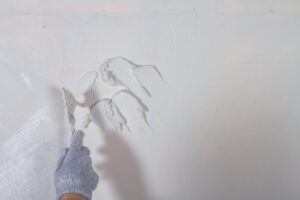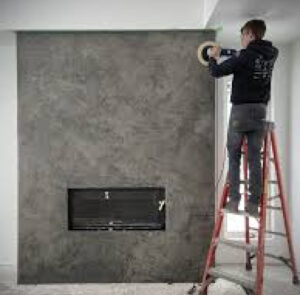Can you paint over Venetian plaster?
Venetian plaster may have a smooth shiny finish or textured finish. Regardless of how fantastic the finish is, if you don’t like the paint obviously you would want to paint your favorite color over it. You can paint over Venetian plaster. But if the plaster is coated with wax then first you have to get the wax cleaned.
In this blog, we will give a step-by-step guide on how you can paint over Venetian plaster with ease.
Understanding Venetian Plaster

Venetian plaster is a unique kind of plaster that originated in Venice, Italy, during the Renaissance period.
It is made from a combination of slaked lime, marble dust, and natural pigments, which are applied in multiple thin layers to create a smooth, polished surface that looks like marble. The technique involves troweling the plaster onto the wall in overlapping strokes, followed by burnishing to achieve a lustrous sheen.
Advantages of Venetian Plaster
Venetian plaster offers several advantages over traditional wall finishes. It is:
- Durable
- Breathable
- Resistant to mold and mildew.
One of the biggest advantages or plus points of getting Venetian plaster is it will give you a shiny marble-like finish at a relatively low cost.
How to Paint Over Venetian Plaster
Before you start painting, there are a few things you need to do.
First, you have to check whether the plaster has a wax coating or not. Most Venetian plaster has a wax coating to appear shiny. If it has wax then you will have to remove it.
The second thing is, that you have to inspect what type of Venetian plastering it is. It can be either of two, which are:
- Polished marble plaster (most likely has wax coating)
- Textured Venetian plaster
If it is polished marble plaster and has wax then you have to remove the wax before you start painting.
While you are inspecting your wall, check for any damages like cracks or holes. If you find any damage then fix it prior to painting.
Don’t forget the most crucial part, which is to choose the right paint.
If this looks a bit overwhelming to you then you may contact the best commercial painting service in Miami.
Choosing the Right Paint

If you feel a bit lost on what paint to choose then this section is for you. Here are some factors to consider when choosing the right paint:
- Type of Paint: Opt for a high-quality latex or acrylic paint specifically formulated for use on textured surfaces. These paints are flexible and breathable, allowing them to adhere well to the Venetian plaster without cracking or peeling.
- Color and Finish: Choose a paint color and finish that complements the desired aesthetic of your space. Matte and eggshell finishes are popular choices for Venetian plaster walls, as they help to enhance the texture and depth of the finish.
- Coverage and Durability: Look for paint products that offer excellent coverage and durability, ensuring long-lasting results. Consider paints with built-in primers or stain-blocking properties to prevent any discoloration from bleeding through.
- Environmental Considerations: Pay attention to the environmental impact of the paint you choose, opting for low-VOC or zero-VOC formulas whenever possible. These paints are safer for both indoor air quality and the environment.
By carefully selecting the right paint for your Venetian plaster project. By choosing the right type of paint you can ensure a beautiful and durable finish that will stand the test of time.
If you want some idea of what the painting trends are at the moment then check Top Painting Trends.
Step-by-step Guide on Painting Over Venetian Plaster
1. Remove any existing wax
You can not paint over wax. If the Venetian plaster has a marble finish then most likely it has a wax coating.
To remove the wax you will need:
- Mineral spirit/ wax cleaner
- A rug or cloth
Use the cloth to dip it into the mineral spirit and start rubbing it on your Venetian surface. After a while, you will notice the wax is coming off. Keep patience and rub the whole wall to remove the wax.
After removing the wax, give the wall a nice bath using soapy water and a cloth. It will clean any debris left on the wall.
2. Let the wall dry
After you have successfully removed the wax and cleaned it with soap and water, let it dry.
Applying primer or paint over a wet surface may cause issues for you.
3. Apply primer
Apply primer on the wall. Primer will penetrate the Venetian plaster while adhering to the paint you put over it. It gives a nice and strong grip to your paint and makes it last longer.
4. Apply paint
After applying primer you can apply the first paint coat. Depending on the type of paint, you may need to give the space enough access to fresh air to keep the air breathable.
You can apply two more coats, this is to ensure the paint stays strong against wear and tear.
How to Maintain Valentina Plaster Walls After Painting
Good job on completing the painting over your Venetian wall, now check out this maintenance guideline.
Dust Removal
Use a soft-bristle brush or a dry microfiber cloth to gently remove dust and debris from the surface of the Venetian plaster.
Regular dusting prevents buildup and maintains the plaster’s appearance.
Gentle Cleaning Solution
Prepare a cleaning solution using warm water and a mild detergent or soap.
Avoid harsh chemicals or abrasive cleaners, as they can damage the plaster’s finish.
Damp Cleaning
Dampen a soft cloth or sponge with the cleaning solution.
Wring out excess water to prevent over-saturation.
Gently wipe the surface of the Venetian plaster in a circular motion, focusing on areas with stains or dirt buildup.
Rinsing
After cleaning, rinse the surface with clean water to remove any soapy residue.
Use a separate cloth or sponge dampened with plain water for rinsing.
Tips
While painting over Venetian plaster may seem daunting, following these tips can help streamline the process and ensure a successful outcome:
- Work in Small Sections: Paint one small section of the wall at a time, focusing on achieving even coverage and blending the paint seamlessly with the surrounding areas.
- Use High-Quality Tools: Invest in high-quality brushes, rollers, and paint trays to achieve professional-looking results. These tools will help ensure smooth application and even coverage.
- Allow Sufficient Drying Time: Be patient and allow each coat of paint to dry completely before applying additional coats or proceeding to the next step in the process. Rushing the drying process can result in uneven coverage and poor adhesion.
- Inspect and Touch Up as Needed: Once the paint has dried, inspect the walls for any areas that may require touch-ups or additional coats. Use a small brush to carefully touch up any imperfections or uneven spots.
- Protect and Maintain the Finish: Once the painting process is complete, take steps to protect and maintain the newly painted finish. Avoid placing heavy objects or furniture against the walls, and clean any spills or stains promptly to prevent damage to the paint.
Final Thoughts
Painting over Venetian plaster is indeed possible with the right preparation. By understanding the process involved and following the step-by-step guide we have provided in this blog, you can paint your Venetian wall with a quality finish.
Painting is not the end of it though. You have to maintain the wall properly or the paint won’t last as long as it would have.
Frequently Asked Questions [FAQs]
Can I paint my Venetian plaster wall all by myself?
Yes, you can, but if you do not feel confident then make sure to call professionals as they can paint your Venetian plaster with expertise.
What is the best paint for Venetian plaster?
Latex paint is one of the best paints when it comes to painting Venetian plaster.
Is it ok to paint over wax?
No, if your Venetian plaster wall has wax coating then you have to remove it before painting.